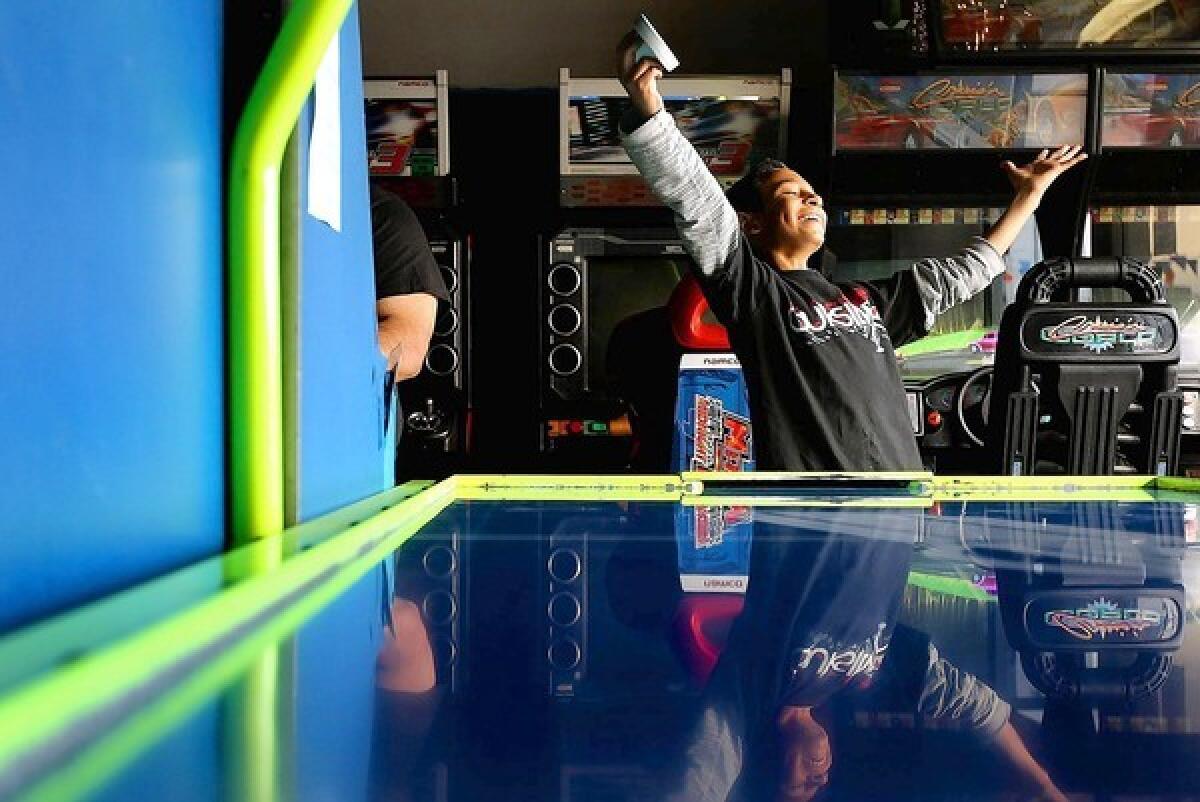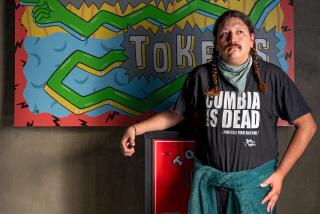Game over: Family Fun arcade is pulling the plug

Inside, the Family Fun Arcade is dark, even on a sunny day. In the back, there’s a counter where you can get change, buy a can of soda for 75 cents and grab a bag of Doritos or a cellophane-covered brownie. The place is noisy, always noisy, not with the flashy whining arpeggios of slot machines or the squeals and songs common to a Chuck E. Cheese but the booms, beeps, blasts and hai-ya’s particular to Street Fighter.
Despite the name, Family Fun is not the typical kiddie-enticing arcade. There are no redemption games here — no Skee-Ball machines spitting out tickets to trade for plastic trinkets, no claws feebly grasping at plush toys. An air hockey table stands near the door, but everything else is joysticks, buttons and video.
Yet as modest as it appears, this Granada Hills arcade, called FFA for short, is legendary in certain circles, a “Street Fighter” mecca known far and wide. “We would get guys from Canada, Japan, Australia, because of the level of competition here,” says owner Ralph Sehnhert. “These guys are like chess masters. They know every nuance of the game, to how many frames per second and what move counteracts what. Their strategy is absolutely amazing. They live and breathe it.”
VIDEO GAMES: The year in gaming hints at indie possibilitites
Which is why members of the fighting-game community are upset with Sehnert for deciding to finally close the arcade that’s been a Valley institution for 39 years and one of only about half a dozen freestanding arcades left in Los Angeles. “But in a good-natured way,” he says. When Family Fun is gone (officially, it will close Monday), it will take with it something that newer forms of video game play lack: the camaraderie that grows around a place devoted exclusively to meeting and competing, in person.
“It’s like Cheers, where everybody knows your name,” says employee Isaiah Allen. “There’s something about being at a mom-and-pop place. This whole atmosphere brings in the social aspect a lot better as opposed to what you would get playing at home on an Xbox.”
Home consoles like Xbox and Wii, however, have slowly eroded the coin-op business, as has the growth of online gaming and games built into smartphones. A rent increase on the space, coupled with health issues, made Sehnertdecide it was finally time to pull the plug.
Allen, 38, first started coming to the arcade at age 15, when he and a friend would make the nearly four-mile walk from his home to the arcade almost daily. Taking the bus would have been quicker but would have used up valuable quarters.
Allen, one of four employees, says he doesn’t know what, if anything, could replace the arcade experience, where customers have turned into lifelong friends. “You learn more etiquette,” he says of the face-to-face competition. “Watch kids playing Xbox — if you’ve ever heard the way they talk, it will shock you. Here, you can be huffing and puffing, but you can’t just go around saying rude things, because the person is right there.”
Although a wide variety of people have walked through the doors, the clientele skews heavily toward young males. Peter Park, 22, who lives in the neighborhood, has a PlayStation 3 at home but comes here for games with friends. “Instead of spending $60 for a new game, you can come in here for a few quarters and try all of the games. And everything is free on New Year’s Eve.”
HERO COMPLEX: Video game coverage
Victor Gonzales, 21 — a.k.a. “NinjaStrike77” — here with friends on a Saturday night, has been coming to FFA a couple of times a week since 2006. He also has a PS3 but likes the arcade environment. “It’s relaxing. You have your chair, your own TV, your own place to sit.”
When he was a teen, Gonzales would be excited to get his weekly allowance every Sunday morning, and then cash in hand, he would head straight to Family Fun and play games until there were just a few quarters left in his pocket — enough for bus fare home. Gonzalez also met his girlfriend here, a gamer girl who he first noticed playing House of The Dead.
“What we used to have going for us was that we were the unique experience you couldn’t get at home,” Sehnert says. “Now, you can sit in your pajamas, play against some guy in Amsterdam or Yugoslavia with a seamless connection, and you don’t have to keep going into your pocket to put quarters in.”
That’s another stumbling block to coin-op economics: the quarter. While prices of virtually everything have risen since Family Fun first opened, it’s hard to jack up the per-play price of a game, Sehnert says.
In the arcade’s early days, mechanical games like faux-rifle-equipped shooting galleries and pinball — newly legalized in Los Angeles — dominated. Air hockey had just been invented, as had the first video game, “Pong.” In the early 1980s, “Pac-Man” fever spiked, then cooled. “Dragon’s Lair,” the laserdisc game, was supposed to revive the sagging industry. It didn’t.
For a time, home video games and arcade games worked in tandem, much like movie theaters and home video — games would be released to arcades first, then a year or so later to consoles. But soon, the coin-free home consoles began to gain on dedicated games in huge wooden cabinets. “One of the things that hurt us in the long run was that manufacturers didn’t want to sell us just the PC board and the artwork so that we could put it in our already used but fine cabinet,” Sehnert says, forcing operators to spend as much as $5,000 per game. “Manufacturers made more firewood than we could stand. They killed the goose that laid the golden egg.”
A hands-on businessman, Sehnert saw another upswing in the form of one-on-one fighting games, and he pioneered a method of wiring two separate cabinet games together so players could go head to head. That and Sehnert’s saavy move to be the first arcade in the U.S. to get the hotly anticipated Street Fighter IV in 2008 fueled one last wave of success.
Yet recent events only confirm Sehnert’s decision to close. A tournament held this month that devotees organized to raise funds for his post-cancer medical bills had the arcade jam-packed — so crowded that police came at 2 a.m. to shut down what was planned as a 24-hour event.
Yet people weren’t putting as many quarters in the machines as they would have on a typical Saturday night 10 years ago. But what surprised Sehnert was the emotional outpouring from so many patrons. One said, “A few years ago, I was in a bad place, but one day I came in here, I found a game, and I felt like I was part of something.”
More to Read
The biggest entertainment stories
Get our big stories about Hollywood, film, television, music, arts, culture and more right in your inbox as soon as they publish.
You may occasionally receive promotional content from the Los Angeles Times.










